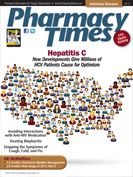Publication
Article
Pharmacy Times
Hemostasis and Thrombosis Issues
Author(s):
Atrial fibrillation (AF) is the most common sustained arrhythmia; it affects more than 2.5 million individuals in the United States and its prevalence is increasing.1 It is estimated that 12 million individuals could have AF by 2050. AF is associated with significant morbidity and mortality.
Uncontrolled AF often causes short- and long-term hemodynamic compromise, particularly in patients who cannot tolerate high heart rates, such as elderly patients and those with underlying structural heart disorders.2 Overall morbidity and mortality from AF is most often caused by thromboembolic events, 3 and patients require chronic systemic anticoagulation. In such cases, the stasis of blood in the fibrillating atria provides an opportunity for thrombus formation, particularly in the atria appendage.4 Left atrial and left atrial appendage thrombi can be the sources of systemic embolism, most significantly cerebral thromboembolism and subsequent stroke.
AF confers a 5-fold relative increase in the risk of stroke. Population-based studies 5 have estimated an absolute risk of stroke of about 2% to 5% in patients with nonvalvular AF who are not on systemic anticoagulation. Although this stroke risk due to AF is relatively low in younger patients, it increases to about 1.5% in patients 50 to 59 years of age. In patients aged 80 to 89 years, nearly 25% of strokes are attributable to AF. Stroke is the leading cause of death from AF, and AF-related strokes cause greater morbidity and mortality than ischemic strokes of other etiologies.6
A cerebrovascular accident, also known as stroke or brain attack, is the most common and devastating complication of AF. Transient ischemic attacks (TIAs) are also common and may be a precursor to a stroke. 1 A stroke is a medical emergency. Strokes happen when blood flow to the brain significantly diminishes or stops. Within minutes, brain cells begin to die. There are 2 kinds of stroke. The more common kind, called ischemic stroke, is caused by a blood clot that blocks or plugs a blood vessel in the brain. The other kind, called hemorrhagic stroke, is caused by a blood vessel that ruptures and bleeds into the brain. “Mini-strokes,” or TIAs, occur when the blood supply to the brain is briefly interrupted and restored, usually without therapy. TIAs have a short duration, usually without major cell death occurring.
Symptoms of stroke include sudden numbness or weakness of the face, arm, or leg (especially on 1 side of the body); mental confusion; trouble speaking or understanding speech; problems seeing in 1 or both eyes; trouble walking, dizziness, or loss of balance or coordination; and severe headache with no known cause. A person experiencing any of these symptoms should get to a hospital quickly to begin treatment. Acute stroke therapies try to stop stroke progression while it is happening by quickly dissolving the blood clot or by stopping the bleeding.
Thrombolytic (fibrinolytic) drugs help reestablish blood flow to the brain by dissolving the blood clot(s) that are blocking the flow. 7 In June 1996, the “clot-buster” Activase (Alteplase recombinant), a tissue plasminogen activator, became the first acute ischemic stroke treatment to be approved by the FDA. To be effective, thrombolytic therapy should be administered as quickly as possible. Intravenous alteplase is approved for use within 3 hour of ischemic stroke onset, with a goal “door to needle” time of 60 minutes or less.
The benefits of thrombolytic therapy administered after 3 hours were recently examined. A meta-analysis of randomized controlled trials suggested that thrombolytic treatment benefited patients with ischemic strokes when it was administered up to 4.5 hours after stroke onset. 7 This analysis compared outcomes in patients treated between 3 and 4.5 hours with those treated within 3 hours. Researchers compared 664 patients presenting with ischemic stroke and given intravenous altepase (0.9 mg/ kg total dose) between 3 and 4.5 hours with 11,865 patients treated within 3 hours. Outcome measures were symptomatic intracerebral hemorrhage within 24 hours, mortality, and independence at 3 months.
Researchers reported no significant difference between the 3 to 4.5 hours cohort and the within 3 hours cohort for any outcome measure, including rate of symptomatic intracerebral hemorrhage, which was 2.2% (14 of 649) and 1.6% (183 of 11,681) (odds ratio 1.18; 95% confidence interval .89-1.55; P = .24), respectively. Researchers concluded that alteplase remains safe when given at 3 and 4.5 hours after ischemic stroke, offering an opportunity for patients who cannot be treated within the standard 3-hour time frame. PT
References:
1. Fuster V, Ryden LE, Cannom DS, et al. 2011 ACCF/AHA/HRS focused updates incorporated into the ACC/AHA/ESC 2006 guidelines for the management of patients with atrial fibrillation: a report of the American College of Cardiology Foundation/American Heart Association Task Force on Practice Guidelines. Circulation. 2011;123(10):e269-e367.
2. Morandy F, Zipes DP. Atrial fibrillation: clinical features, mechanisms, and management. In: Bonow RO, Mann DL, Zipes DP, Libby P, eds. Braunwald’s Heart Disease: a Textbook of Cardiovascular Medicine. 9th ed. Philadelphia, PA: Saunders/Elsevier; 2011.
3. Hart RG, Pearce LA, Miller VT, et al. Cardioembolic vs. noncardioembolic strokes in atrial fibrillation: frequency and effect of antithrombotic agents in the stroke prevention in atrial fibrillation studies. Cerebrovasc Dis. 2000;10:(1):39-43.
4. Wolf PA, Abbott RD, Kannel WB. Atrial fibrillation: a major contributor to stroke in the elderly: the Framingham Study. Arch Intern Med. 1987;147(9):1564-1564.
5. Singer DE, Chang Y, Fang MC, et al. The net clinical benefit of warfarin anticoagulation in atrial fibrillation. Ann Intern Med. 2009;151(5):297-305.
6. Hart RG, Pearce LA, Aguilar MI. Meta-analysis: antithrombotic therapy to prevent stroke in patients who have nonvalvular atrial fibrillation. Ann Intern Med. 2007;146(12):857-867.
7. Wahlgren N, Ahmed N, Dávalos A. Thrombolysis with alteplase 3-4.5 hours after acute ischaemic stroke (SITS-ISTR): an observational study. Lancet. 2008;372(9646):1303-1309.
Mr. Brown is professor emeritus of clinical pharmacy and a clinical pharmacist at Purdue University College of Pharmacy, Nursing, and Health Sciences, Department of Pharmacy Practice, West Lafayette, Indiana.







